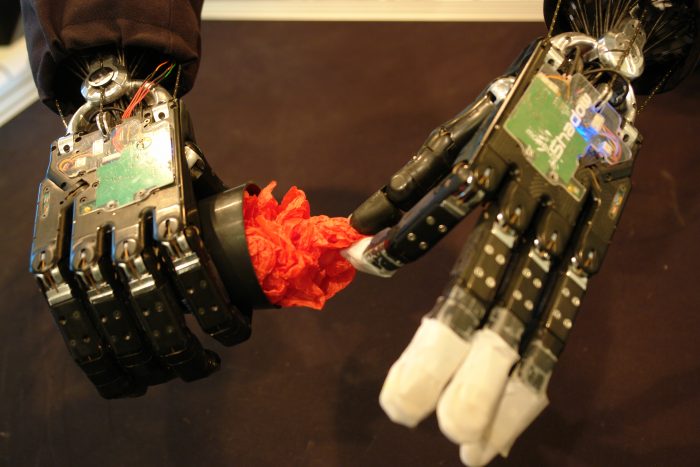Company News
Nov 12, 2017
Case Study: NeuroInformatics Group @ Bielefeld University
Cast your minds back, way back, to 2004. Martha Stewart was sent to prison, Janet Jackson had a wardrobe malfunction, and Ocean’s Twelve was in the cinema. Make of that what you will. However, the most thing that happened to us that year is that we had our first customer for the initial version of the Shadow Dexterous Hand.

Our first customer was The NeuroInformatics Group at Bielefeld University, led by Prof. Dr. Helge Ritter. The aim of their work is to strive for a deeper understanding of the required interplay of adaptive control, embodiment, knowledge, and learning to enable cognitive interaction for robots or intelligent interfaces.
In contrast to today’s engineered systems (that rely on an almost complete specification of their numerous details), neural systems are shaped by self-organisation, adaptation and learning and therefore can flexibly adapt to new situations.
To gain insights into the working principles of these systems and to replicate similar functions in technology, the NeuroInformatics Group brings together methods from neural networks, machine learning, computer vision, dynamical systems and control, embracing topics such as data mining, brain-machine interfaces, evolutionary computation and complex systems integration, and drawing cross-disciplinary inspiration from brain science, psychology and linguistics.
They told us “We are striving to understand human manual intelligence and replicate it in artificial robot systems. To this end, the Shadow Robot Hands serve as a unique test bed for our control approaches to achieve human-like grasping and manipulation performance. Having equipped the hands with custom-made tactile sensors, providing more than 90 taxels spread all over, we are particularly looking into tactile and vision-driven control loops for bimanual manipulation.”
“With its unique, human-like design the Shadow Hands serve as the perfect test bed to design, evaluate, and improve computational models of human manual intelligence. Here we particularly need hands of human size and dexterity.”
Due to the intimate connection between neural networks and the control of behaviour, robotics is considered the major test bed for algorithms and computational models. In the work of the NeuroInformatics Group, the focus is particularly on manual intelligence and its replication for articulated robot hands. Utilizing eye-, motion-, and force-tracking systems, they study human manipulation actions and subsequently turn their insights into appropriate robot control strategies, utilizing tight tactile- and vision-driven feedback loops to achieve robust behaviour. In cooperation with other research groups, they’re working towards robot systems that can be taught in an interactive manner.
The group have been loyal repeat customers of ours, buying updated hands once they’ve been released. They even made us this amazing birthday card for us! Make sure you click this link to read more about the work that the NeuroInformatics Group do. It’s fascinating and we’re proud to call them our clients!